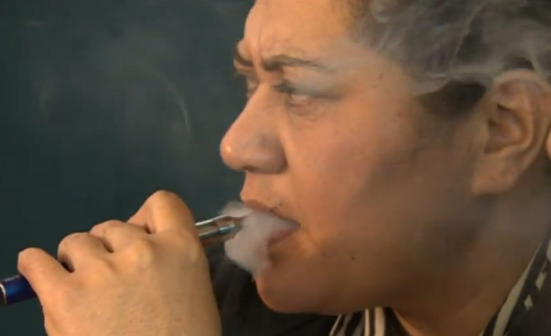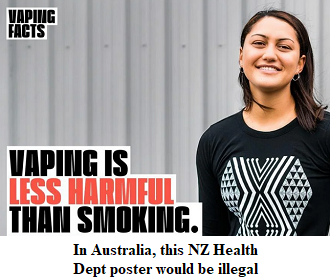
The TGA’s Vaping Ban and Aboriginal Health

In April 2020, Quadrant contributor Dr Anthony Dillon wrote in Our Coming Bleak Winter and Beyond: “Until political leaders find the courage to reclaim responsibility for the state of the nation, the [COVID] virus and far more damaging policies imposed to combat it cannot, and will not, be separated.” He then encouraged these politicians and their sundry and assorted ‘experts’ to do “more thinking and less talking.”
One thing that certainly deserves “more thinking” is the recently introduced ban on nicotine-infused ‘vape juice’ for use in electronic cigarettes. That ban affects all Australians keen to shed their addictions to traditional cigarettes via the vaping substitute, and it hits Aborigine smokers, among the nation’s heaviest cigarette smokers, hardest of all.
The ban on nicotine vaping products (NVPs) began late in 2021, the Therapeutic Goods Administration (TGA) outlining it as follows (emphasis added):
From 1 October 2021, consumers require a prescription for all purchases of nicotine vaping products, such as nicotine e-cigarettes, nicotine pods and liquid nicotine. This includes purchases from Australian pharmacies and from overseas. It remains illegal for other Australian retailers, such as tobacconists, ‘vape’ shops and convenience stores, to sell you nicotine vaping products, even if you have a prescription.
At the same time the TGA was formulating its edict, the Productivity Commission (PC) was examining Overcoming Indigenous Disadvantage (OID), an overview that included “tobacco consumption and harm”. The PC’s latest OID report was released in December 2020 and includes a chapter, of over 500 pages, on “healthy lives”. Three of the PC’s findings: (1) “smoking is still the single biggest contributor to the burden of preventable ill health and death”; (2) “mental illness and the overall mental wellbeing [is] influenced by a range of factors including … substance misuse”; and (3) “the first point of contact with the health system enables prevention, early intervention, case management and ongoing care”. The latter includes: “local general practitioners (GPs) [and] pharmacists”.
The Australian Institute of Health and Welfare (AIHW) has conducted a National Drug Strategy Household Survey (NDSHS) every two to three years since 1985. The latest one, for 2019, was published in July 2020. General population results re smoking included: (1) “Fewer Australians are smoking daily than ever before—11.0% in 2019, down from 12.2% in 2016 and 24% in 1991.” (2) “More smokers said the cost of smoking was motivating them to quit or cut back—58% in 2019 compared with 52% in 2016.” (3) “3 in 10 smokers do not plan on quitting—this proportion has not changed over the last decade.” Further results re NVP include: (5) “Use of e-cigarettes is increasing—between 2016 and 2019, lifetime use and current e-cigarette use increased for smokers and non-smokers, as did frequency of use.” (6) “Fewer dependent children were exposed to daily tobacco smoke inside the home, declining from 19.7% in 2001 to just 2.1% in 2019 (and down from 2.8% in 2016).”
AIHW’s also has specific NDSHS 2019 results for “Indigenous Australians” re smoking including: (7) “The proportion of Indigenous Australians aged 14 and over smoking daily has been declining since 2010, from 35% in 2010 to 25% in 2019” 8.) “After adjusting for differences in age, Indigenous Australians were 2.5 times as likely as non-Indigenous Australians to smoke daily (27% compared with 10.8%).” And given the interactions of alcohol, cannabis and pharmaceuticals with tobacco smoking, it is worth noting that: (9) “Between 2016 and 2019, there was a considerable decrease (from 28% to 17.7%) in Indigenous Australians drinking in excess of the recommended guidelines[.]” (10) “Between 2016 and 2019, there were non-statistically significant declines in the recent use of cannabis (from 19.4% to 16.0%) and pharmaceuticals used for non-medical purposes (10.6% to 7.0%).”
AIHW’s NDSHS 2019 did not address Indigenous Australians vaping per se but the following overall population results in response to the question, “Why do people use e-cigarettes?” are very instructive in this regard:
(11) “to help me quit smoking (32% in 2019, similar proportion to 2016, 31%)”;
(12) “I think they are less harmful than regular cigarettes (23%, up from 19.2%)”;
(13) “to try to cut down on the number of cigarettes smoke/smoked (22%, up from 18.7%)”;
(14) “to try to stop me going back to smoking regular cigarettes (17.8%, up from 14.5%)”;
(15) “they are cheaper than regular cigarettes (17.7%, up from 10.5%)”.
Regarding vaping being “less harmful”, Public Health England (PHE) concluded in 2015 that: “the current best estimate is that e-cigarettes are around 95% less harmful than smoking. [As well as] there is no evidence so far that e-cigarettes are acting as a route into smoking for children or non-smokers[.]” PHE followed this up in 2016 by stating that:
We know that e-cigarettes are the most popular quitting tool in the country with more than 10 times as many people using them than using local stop smoking services” … The current national evidence is that in the UK regular e-cigarette among youth use is almost exclusively confined to those young people who have already smoked … And yet, millions of smokers have the impression that e-cigarettes are at least as harmful as [smoking] tobacco.
By contrast, the TGA’s Dr John Skerritt was quoted as recently as February 2021 as saying:
I believe that smoking is more harmful than vaping but that does not make vaping harmless – in the same way that being hit by a car on the freeway is less harmful than being hit by a truck, but it is not desirable.
This attitude is consistent with the (largely justifiable) ‘war on smoking’ morphing into the wholly unjustifiable war on vaping. For example, the Australian Criminal Intelligence Commission (ACIC) has a National Wastewater Drug Monitoring Program (NWDMP) which in 2021 measured
Compounds of concern include nicotine [as it] is the main psychoactive substance present in tobacco products [but] the method cannot distinguish between nicotine intake from tobacco, electronic cigarettes and nicotine replacement therapies such as patches and gums.
They found:
The rise in nicotine use in some jurisdictions since the start of the Program in 2016 accelerated after the start of the COVID pandemic
The war on vaping is certainly on in Australia and the US, but the UK and New Zealand fortunately did not get the  WHO Memo insisting, unscientifically, that vaping is as bad if not worse than smoking. The situation in NZ, in terms of Indigenous Māori in particular, was described by Filter Magazine in October 2020 as follows:
WHO Memo insisting, unscientifically, that vaping is as bad if not worse than smoking. The situation in NZ, in terms of Indigenous Māori in particular, was described by Filter Magazine in October 2020 as follows:
Smoking rates among Indigenous peoples have remained stubbornly high around the world … Te Piki Oranga, a Māori primary health provider, offers a harm reduction-based quit-smoking program called Te Hā (The Breath). … Te Hā offers nicotine gum, patches, lozenges and vaping devices free of charge—including a first vape pod, although participants later buy their own … The program defines success not only as quitting smoking altogether, but also by measures such as reducing the number of cigarettes smoked, or simply saving money … Te Hā has demonstrated that vaping helps Indigenous people with the highest rates of smoking to quit.
Bearing the New Zealand experience in mind, Australia’s ban on nicotine-infused vapes is both a manifestation of indifference to a serious public health problem and the blanket rejection of a tool that experience elsewhere says can have a beneficial effect.
One great way to address this would be to establish an indigenous vaping pilot program (IVPP) that taps New Zealand’s experience and expertise
On the theory that one directs the most water at the spots where the fire is hottest, the first such IVPP should be in the Northern Territory, which ACIC found, as of April 2021, “the highest estimated average capital city and regional consumption of nicotine.” The most important goal of the IVPP would be to give Indigenous Australians greater and better smoking cessation options as soon as possible.
Given the typical situation in remote communities of being underserved by GPs and pharmacies, the focus should be on legally exempting local and online retailers so they can directly provide nicotine vaping products to Aborigines. Local, state and federal governments need to get to work on this as though lives were at stake — because they are!
Darren Brady Nelson is an Austrian School economist and a C.S. Lewis- and G.K. Chesterton-style Christian. He is currently the Chief Economist at LibertyWorks of Brisbane QLD Australia and a long-time policy advisor to The Heartland Institute of Chicago. He is also a regular commentator in traditional and online Australian and American media.
Dr Anthony Dillon is a researcher at the Institute for Positive Psychology and Education at Australian Catholic University in Sydney. Anthony’s research interests are positive psychology, conceptualization of mental health, wellbeing, and Aboriginal education. He is active as a social commentator on Aboriginal issues and has for many years presented his opinion in the popular media such as Quadrant Online, Spectator Australia and the Sydney Morning Herald.
Madam: Archbishop Fisher (July-August 2024) does not resist the attacks on his church by the political, social or scientific atheists and those who insist on not being told what to do.
Aug 29 2024
6 mins
To claim Aborigines have the world's oldest continuous culture is to misunderstand the meaning of culture, which continuously changes over time and location. For a culture not to change over time would be a reproach and certainly not a cause for celebration, for it would indicate that there had been no capacity to adapt. Clearly this has not been the case
Aug 20 2024
23 mins
A friend and longtime supporter of Quadrant, Clive James sent us a poem in 2010, which we published in our December issue. Like the Taronga Park Aquarium he recalls in its 'mocked-up sandstone cave' it's not to be forgotten
Aug 16 2024
2 mins







